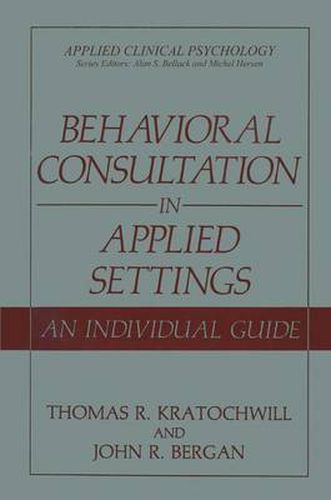Readings Newsletter
Become a Readings Member to make your shopping experience even easier.
Sign in or sign up for free!
You’re not far away from qualifying for FREE standard shipping within Australia
You’ve qualified for FREE standard shipping within Australia
The cart is loading…






This title is printed to order. This book may have been self-published. If so, we cannot guarantee the quality of the content. In the main most books will have gone through the editing process however some may not. We therefore suggest that you be aware of this before ordering this book. If in doubt check either the author or publisher’s details as we are unable to accept any returns unless they are faulty. Please contact us if you have any questions.
This guidebook has been developed as a skill-training package to teach psychologists, counselors, social workers, and other applied mental-health professionals a model for the delivery of behavioral interventions through a behavioral consultation approach. This train ing guide is an abridged version of the skills taught as part of a behavioral consultation model. As such it is not intended to be an exhaustive program in behavioral consultation. Usually, consultation skills are taught over a period of several months in university training programs. Also, the most successful use of the guidebook can be accom plished only with prerequisite training in behavioral analysis and assessment as a method of delivering psychological services. Thus, individuals using this guidebook should obtain supervised training in this area. The book is also designed to accompany Bergan and Kratochwill (1990). Some individuals may have a background in behavioral assess ment and intervention. In this case, the use of this guidebook can provide the user who has not been exposed to the specifics of the behavioral consultation approach valuable information regarding in terviewing forms of assessment and intervention. Such activities can be extremely useful when incorporated into regular clinical work in applied settings and supplemented with other assessment and inter vention methods. Given the importance of successful interviewing in applied settings, a major clinical tool should be available after careful study of this guidebook.
$9.00 standard shipping within Australia
FREE standard shipping within Australia for orders over $100.00
Express & International shipping calculated at checkout
This title is printed to order. This book may have been self-published. If so, we cannot guarantee the quality of the content. In the main most books will have gone through the editing process however some may not. We therefore suggest that you be aware of this before ordering this book. If in doubt check either the author or publisher’s details as we are unable to accept any returns unless they are faulty. Please contact us if you have any questions.
This guidebook has been developed as a skill-training package to teach psychologists, counselors, social workers, and other applied mental-health professionals a model for the delivery of behavioral interventions through a behavioral consultation approach. This train ing guide is an abridged version of the skills taught as part of a behavioral consultation model. As such it is not intended to be an exhaustive program in behavioral consultation. Usually, consultation skills are taught over a period of several months in university training programs. Also, the most successful use of the guidebook can be accom plished only with prerequisite training in behavioral analysis and assessment as a method of delivering psychological services. Thus, individuals using this guidebook should obtain supervised training in this area. The book is also designed to accompany Bergan and Kratochwill (1990). Some individuals may have a background in behavioral assess ment and intervention. In this case, the use of this guidebook can provide the user who has not been exposed to the specifics of the behavioral consultation approach valuable information regarding in terviewing forms of assessment and intervention. Such activities can be extremely useful when incorporated into regular clinical work in applied settings and supplemented with other assessment and inter vention methods. Given the importance of successful interviewing in applied settings, a major clinical tool should be available after careful study of this guidebook.